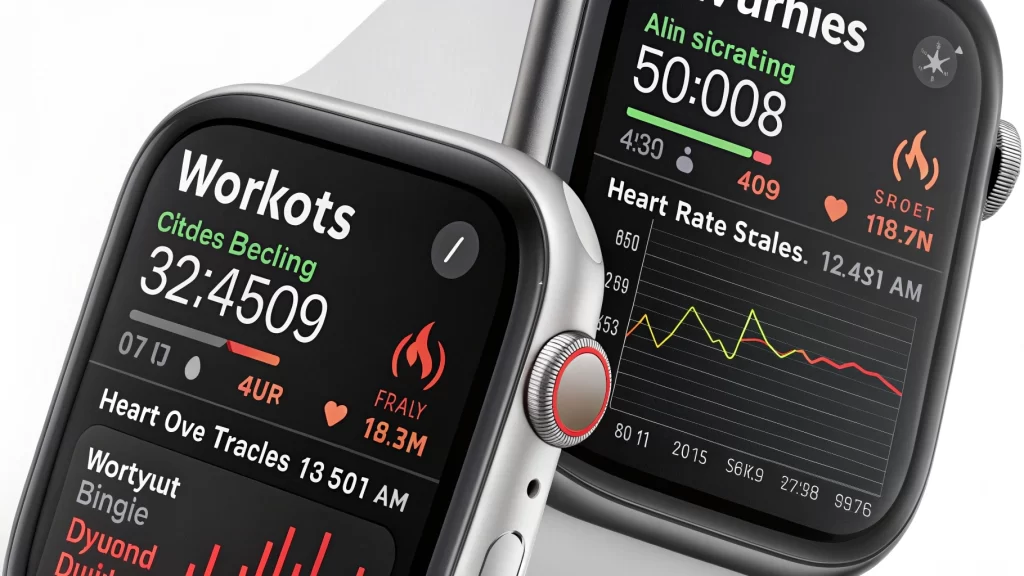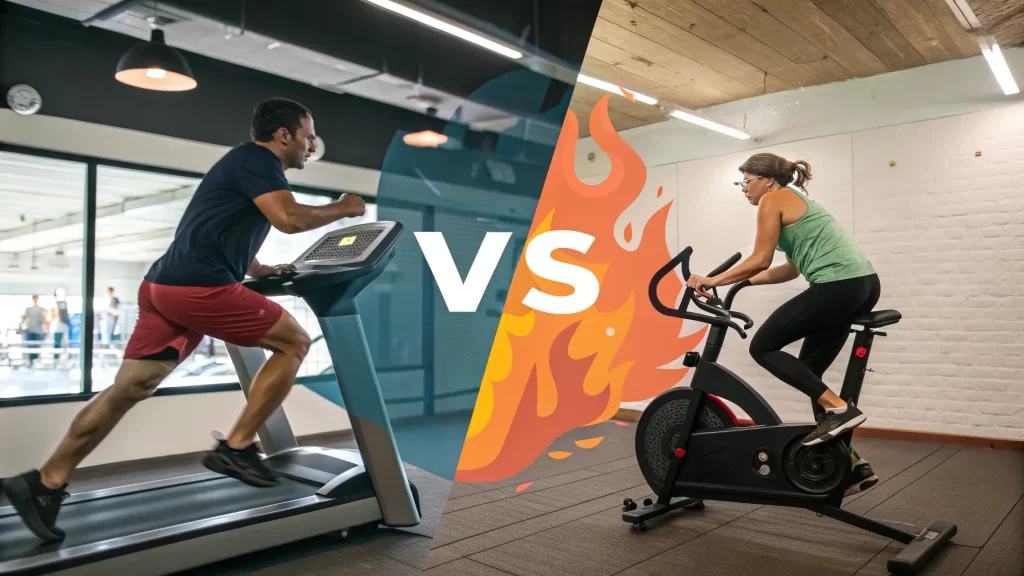Let’s settle this fitness feud once and for all. You’re standing in the gym, eyeing both the treadmill and that sleek indoor cycling bike, wondering which one’s going to help you shed those stubborn pounds faster. We’ve all been there—paralyzed by choice in the cardio section.
The battle of Indoor Cycling vs Treadmill workouts isn’t just gym small talk. It’s a legitimate question that deserves a data-driven answer, especially when your weight loss goals are on the line. Both machines promise to torch calories and transform your physique, but which one delivers?
In this article, we’re cutting through the fitness mythology with cold, hard facts. We’ll break down the calorie burn, joint impact, practicality, and long-term effectiveness of both workout styles. No bro-science, just evidence-based comparisons to help you make the smartest choice for your body and goals.
Indoor Cycling vs Treadmill: The Calorie-Burning Showdown
Let’s get straight to what you’re probably most curious about: which machine helps you burn more calories?
Research suggests that treadmill running generally burns slightly more calories per minute compared to stationary cycling. Studies show a range of 8.18 to 10.78 calories burned per minute for treadmill running, while stationary cycling burns approximately 7.98 to 10.48 calories per minute. Over a 30-60 minute session, this difference might seem significant.

But here’s where it gets interesting—and why you shouldn’t necessarily sprint to the treadmill section just yet. The Journal of Strength and Conditioning Research found that running on a treadmill burned between 490 and 646 calories per hour, while an exercise bike burned between 478 and 628 calories for the same duration. That’s a difference of just 12-18 calories per hour. For context, that’s about the caloric equivalent of a single celery stick.
The real calorie-burning potential comes down to intensity, not the machine itself. Cranking up the resistance on a stationary bike can easily outpace a leisurely treadmill jog in terms of calorie expenditure. And if you’re curious about just how many calories indoor cycling can burn, check out our detailed breakdown of the exact numbers you can expect.
What changes the game for both machines is incorporating High-Intensity Interval Training (HIIT). This approach—alternating between intense bursts and recovery periods—dramatically increases calorie burn on either machine. Some newer exercise bike technologies even claim their specialized REHIT (Reduced Exertion High-Intensity Training) protocols burn twice as many calories per minute as traditional jogging.
The bottom line? The machine that will burn more calories is the one you’ll push yourself harder on.
Muscle Engagement: Full Body vs Lower Body Focus
Beyond just burning calories during your workout, the effectiveness of exercise for weight loss also depends on which muscles you’re engaging and how that impacts your metabolism.
Treadmill workouts recruit a broader range of muscles. Running or walking primarily works your quads, hamstrings, calves, and glutes. But you’re also activating your core for stability and your arms and shoulders for balance (especially if you avoid holding the handrails). Bump up the incline, and your glutes, hamstrings, and calves work even harder.
Indoor cycling is more focused, primarily targeting your lower body—specifically the quads, hamstrings, calves, and glutes that power your pedal strokes. While your core gets some action for stabilization, and your upper body might be slightly involved with the handlebars, your legs are doing the heavy lifting.
This difference in muscle engagement directly affects your metabolic rate. Activities that recruit more muscle mass (like treadmill workouts) typically result in higher energy expenditure both during and after exercise. This post-exercise calorie burn—known as the “afterburn effect” or EPOC (Excess Post-exercise Oxygen Consumption)—can be significant for weight loss.
However, don’t count indoor cycling out yet. While it might engage fewer muscles, its low-impact nature could allow you to exercise longer or more frequently, potentially leading to greater cumulative metabolic impact over time. Plus, varying your cycling pace and resistance can enhance your afterburn effect too.
Joint Health: High Impact vs Low Impact
When it comes to the impact on your joints, there’s a clear distinction between these two workout styles.
Indoor cycling is the undisputed champion of joint-friendly exercise. Your feet stay securely on the pedals throughout the motion, eliminating the pounding impact on knees, hips, and ankles. This makes cycling particularly suitable if you’re dealing with joint pain from conditions like arthritis or recovering from injuries.
Treadmill workouts, especially running, are high-impact exercises. Each foot strike on the moving belt creates significant stress on your knees and other joints. This can be problematic if you already have joint issues. Walking on a treadmill is lower impact than running, and modern treadmills often feature cushioned decks that absorb some impact compared to outdoor running.
For both activities, proper form is crucial for joint protection. With indoor cycling, correct bike setup (particularly seat height and position) is essential for preventing knee pain. For treadmill workouts, maintaining proper running form and wearing appropriate footwear with adequate cushioning helps reduce joint stress.
As someone who’s experienced both workout styles firsthand, I can tell you that the difference in how your body feels afterward is noticeable. After an intense cycling session, you’ll feel the muscle fatigue but without the joint discomfort that often follows a hard run. For those concerned about the sustainability of their workout routine, this is a factor worth serious consideration.
Practicality and Convenience: Space, Cost, and Usability
If you’re considering adding either machine to your home gym setup, there are significant practical differences to consider.
Exercise bikes generally win on cost-effectiveness, with prices ranging from approximately $200 to over $2,000 for premium models. Treadmills typically require a higher investment, starting around $500 and reaching upwards of $5,000 for high-end versions.
Space requirements also favor exercise bikes. They’re considerably more compact and take up less floor space than treadmills. Many models are even foldable for convenient storage. Treadmills, being larger and heavier, usually demand a dedicated workout area and are less portable. While foldable treadmills exist, they’re still bulkier and heavier than most exercise bikes.
Both machines are generally user-friendly, offering adjustable settings for speed and resistance/incline. However, treadmills often involve a more complex assembly process. Exercise bikes are frequently highlighted as particularly beginner-friendly due to their straightforward operation.
In my experience, the difference in space requirements alone can be the deciding factor for urban dwellers or those with limited home gym space. A quality exercise bike can fit in the corner of a bedroom or living room, while a treadmill often requires dedicated real estate.
The Enjoyment Factor: What Will You Stick With?
Here’s a truth that fitness professionals sometimes overlook: the “best” exercise for weight loss is the one you’ll do consistently.
Experts generally agree that personal preference plays the dominant role in determining which activity you’re more likely to maintain long-term. If you genuinely enjoy running, you’ll probably stick with treadmill workouts. If cycling feels better to you, an indoor bike will likely see more consistent use.
Both machines offer workout variety to combat boredom. Treadmills let you adjust speed and incline to simulate different terrains and intensities. Exercise bikes offer adjustable resistance for everything from steady-state cardio to intense HIIT sessions.
The growing popularity of interactive features and virtual classes for both types of machines has also enhanced engagement. These technological additions can transform a solitary workout into an immersive, community-based experience.
The lower impact nature of cycling might also contribute to better long-term adherence for some people, particularly those with joint concerns or fitness beginners, as it reduces discomfort and injury risk.
Evidence-Based Weight Loss Effectiveness
When it comes to sustained weight loss, research shows both indoor cycling and treadmill workouts can be effective when performed consistently and combined with proper nutrition to create a calorie deficit.
Several studies have specifically examined indoor cycling’s impact on body composition. A 2017 study demonstrated that 16 weeks of spin bike training led to improvements in body fat percentage among young women[^1]. Another study found that indoor cycling combined with a low-calorie diet effectively reduced both body weight and body fat.
One particularly noteworthy study observed a 3% reduction in body mass and a 5% reduction in body fat mass following a long-term cycling intervention, even without specific caloric restriction. You can learn more about the weight loss benefits of indoor cycling in our comprehensive guide.
The fundamental principle for fat loss remains creating a calorie deficit, and both treadmill workouts and high-intensity cycling can effectively contribute to this by burning significant calories.
Beyond Weight Loss: Additional Health Benefits
Both workout styles offer impressive health benefits beyond just helping you drop pounds.
Cardiovascular health improvements are a major win with either option. Both strengthen your heart muscle, enhance blood circulation, and lower cardiovascular disease risk. Studies show indoor cycling can improve blood pressure, blood fat profiles, and overall aerobic capacity. Similarly, treadmill workouts enhance heart health, endurance, and blood sugar control.
For muscle strengthening, cycling primarily targets and strengthens lower body muscles—quads, hamstrings, calves, and glutes. It also contributes to improved balance and gait. Treadmill workouts offer more comprehensive muscle engagement, working the legs, core, and arms/shoulders. The weight-bearing nature of treadmill exercise also contributes to improved bone density.
Mental health benefits shouldn’t be overlooked either. Both activities can positively impact mood, reduce stress and anxiety, and improve sleep quality.
Making Your Choice: Personalized Recommendations
Experts generally agree that both indoor cycling and treadmill workouts are effective for cardiovascular exercise and weight loss. However, the optimal choice depends on your circumstances.
Treadmills might be your better bet if you:
- Have no pre-existing joint issues
- Are seeking potentially higher calorie burn
- Want a more comprehensive, full-body workout
- Would benefit from the weight-bearing activity for bone density
Exercise bikes might be more suitable if you:
- Experience joint pain
- Are you recovering from injuries
- Have balance issues
- Prefer lower-impact exercise
- Have limited space or budget for home equipment
The recurring theme in expert advice is the paramount importance of personal preference and enjoyment for fostering long-term adherence. The most effective exercise for weight loss is ultimately the one you find engaging enough to perform consistently over time.
The Verdict: It’s Complicated (But in a Good Way)
So, which wins the Indoor Cycling vs Treadmill showdown? The honest answer is: it depends on you.
While treadmill running may provide a slight advantage in immediate calorie expenditure for some individuals, this difference is often negligible and highly dependent on workout intensity and duration. Both effectively engage major muscle groups and contribute to metabolic rate and post-exercise calorie burn.
The most significant distinction lies in joint impact. Indoor cycling offers a low-impact option that’s gentler on your body, while treadmill workouts (especially running) are higher impact. Practical considerations like cost and space often favor exercise bikes, making them more accessible for home use.
The key to successful weight loss through either activity lies in consistency. The machine you enjoy using is the one that will ultimately help you reach your goals. As fitness professionals like to say, the best exercise is the one you’ll do.
When making your decision, consider your calorie-burning goals, preferred muscle groups, any joint issues, budget and space constraints, and most importantly, which activity you’ll look forward to rather than dread.
FAQ: Indoor Cycling vs Treadmill
Which burns more calories: indoor cycling or a treadmill?
Research indicates that treadmill running burns slightly more calories than indoor cycling at comparable intensity levels—about 490-646 calories per hour for treadmill running versus 478-628 calories per hour for stationary cycling. However, this difference is minimal (12-18 calories per hour) and can easily be offset by increasing the intensity of your cycling workout or extending your session length.
Is indoor cycling or a treadmill better for people with joint problems?
Indoor cycling is generally considered the better option for people with joint problems. It’s a low-impact exercise where your feet remain on the pedals throughout the motion, minimizing stress on knees, hips, and ankles. Treadmill running creates a significant impact with each foot strike, which can exacerbate existing joint issues. However, walking (rather than running) on a treadmill offers a lower-impact alternative.
Which is more cost-effective for home use: an exercise bike or a treadmill?
Exercise bikes are typically more cost-effective for home use. Quality exercise bikes range from approximately $200 to $2,000, while treadmills generally cost between $500 and $5,000. Exercise bikes also take up less space, making them more practical for homes with limited room for fitness equipment.
Can I lose weight effectively with either indoor cycling or treadmill workouts?
Yes, both indoor cycling and treadmill workouts can effectively contribute to weight loss when performed consistently and combined with proper nutrition. Studies have shown that both activities can improve body composition and reduce body fat when incorporated into a regular exercise routine. The key factor is creating a calorie deficit through your overall diet and exercise program.
How do I decide between indoor cycling and a treadmill for my workout routine?
Your decision should be based on several factors: your joint health (cycling is lower impact), space and budget constraints (bikes are generally more compact and affordable), your enjoyment (which you’re more likely to stick with), and your specific fitness goals. Many experts recommend trying both activities to determine which one aligns better with your preferences and physical condition. The most effective exercise for weight loss is ultimately the one you’ll perform consistently over time.
Indoor Cycling vs Treadmill: Which is Better for Weight Loss?
The Ultimate Guide for Indoor Fitness Lovers
Read the definitive guide of Indoor Fitness
Leave a Comment





